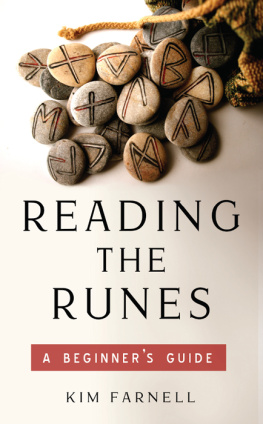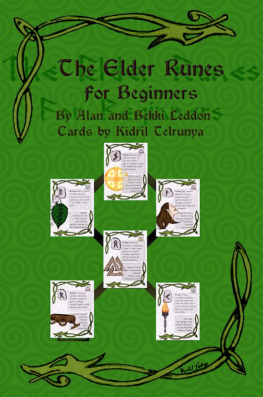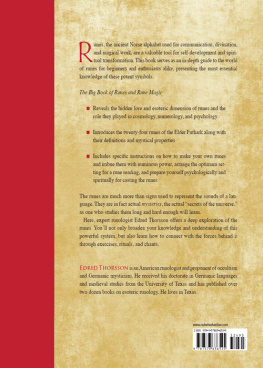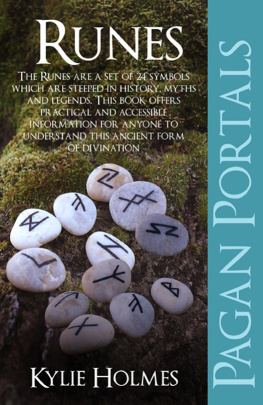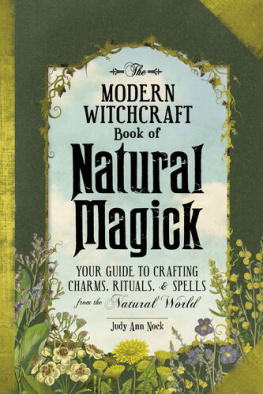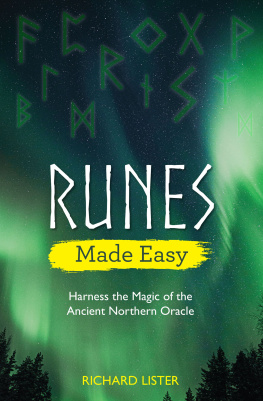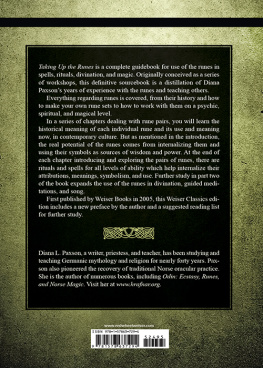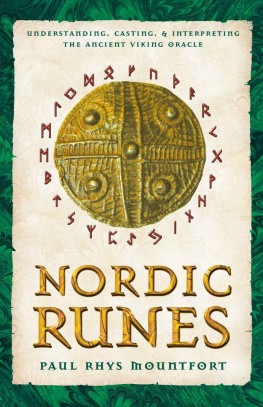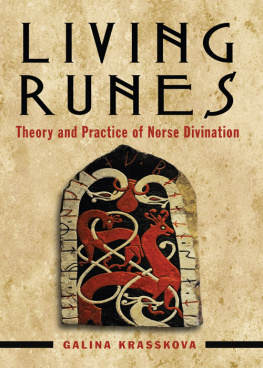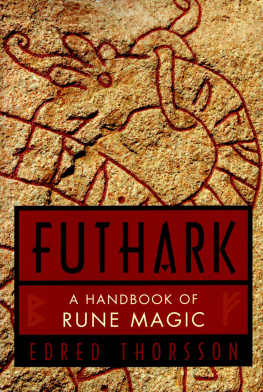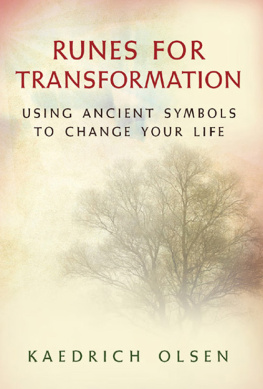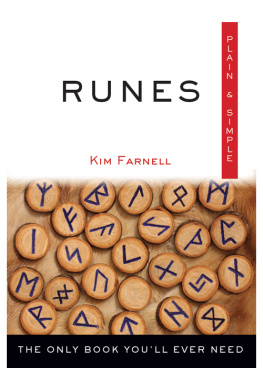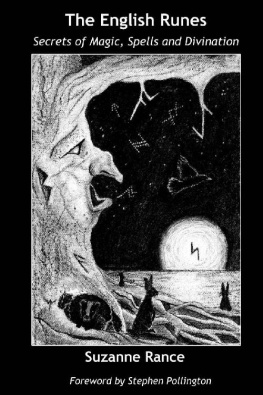

This edition copyright 2019 by Kim Farnell
All rights reserved. No part of this publication may be reproduced or transmitted in any form or by any means, electronic or mechanical, including photocopying, recording, or by any information storage and retrieval system, without permission in writing from Red Wheel/Weiser, LLC. Reviewers may quote brief passages. Previously published in 2003 by Zambezi Publishing Ltd., Devon, UK.
Hampton Roads Publishing Company, Inc.
Charlottesville, VA 22906
Distributed by Red Wheel/Weiser, LLC
www.redwheelweiser.com
Sign up for our newsletter and special offers by going to
www.redwheelweiser.com/newsletter/
ISBN: 978-1-57174-769-3
Library of Congress Control Number: 2018944758
Cover and interior design by Kathryn Sky-Peck
Printed in Canada
MAR
10 9 8 7 6 5 4 3 2 1
Know how to cut them, know how to read them
Know how to stain them, know how to prove them
Know how to evoke them, know how to score them
Know how to send them, know how to spend them
The Havamal
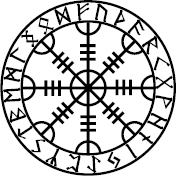
CONTENTS
one
WHAT ARE RUNES?
R unes are letters of an alphabet that developed from extremely ancient illustrations, each of which once had a specific meaning. These glyphs developed into an ancient form of old writing, which can be traced back from markings that appeared on rocks as early as the Neolithic period. Pre-runic symbols have been found in various Bronze Age rock carvings, mainly in Sweden. Some of these are easily identifiable in later alphabets while others represent ideas and concepts incorporated into the names of the runes. They can be found chiselled in rocks throughout the areas inhabited by the Germanic tribes. These people shared a common religion and culture. Their mythology was passed on through an oral tradition. The people of Northern Europe used the rune script until well into the Middle Ages. As well as a written alphabet, runes also served as a system of symbols used for magic and divination. In this way the process of writing becomes a magical act.
Runic letters were used to foretell the future by casting. Runes were also inscribed into tools, weapons, rocks, altars, and personal items. According to mythology, the runic alphabet was discovered by the god Odin while he hung head down for nine days and nights from Yggdrasil, the World Tree that supports the universe. From this position, he spied the rune stones and fell from the tree crying and full of knowledge. Each runic character is connected with a deity from Scandinavian mythology and so contains in it a sequence of meanings derived from the deity's connections and relations.
As Christianity spread into the northern realms, the development of the Nordic mythologies began to fade. However, the Vikings colonized Iceland where Christianity had a much weaker influence. There it was possible to preserve the pre-Christian myths, and it was in Iceland that the Nordic mythologies were first written down.
The use of runes fell into disuse as the Roman alphabets became the preferred script of most of Europe between the thirteenth and sixteenth centuries. Interest in the runes began to rise again in the seventeenth century, and it was then that the Christian Church banned them. Runes have since been rediscovered as a symbolic system and have become very popular as a means of divination.
The runic alphabet is one of the oldest forms of writing known. It is made up of straight lines that cross and break. Each letter, or rune, has its own meaning in addition to being used as part of an alphabet for writing. For example, the first rune, Fehu, is an actual word meaning cattle. What we now know as the runic alphabet has developed from two different sourcesmagical and literate.
Runes as we know them are formed from three main alphabets: the Teutonic, which has twenty-four letters; the Anglo Saxon, with thirty-two letters; and the Scandinavian, with sixteen. It is the Teutonic alphabet that we tend to use for divination today. Many runic characters bear a resemblance to Latin letters, except that runes have few curves, which makes them suitable for carving with a knife.
These different alphabets are referred to as Futharks. The Elder Futhark is basically the Teutonic alphabet. The Younger Futhark contains only sixteen runes, as in the Scandinavian set. There are many variations in the names given to individual runes. There are also variations in the exact shape of certain runes. The Elder Futhark is divided into three groups or aettir and each rune has an assigned place. The name Futhark is derived from the first six runes.
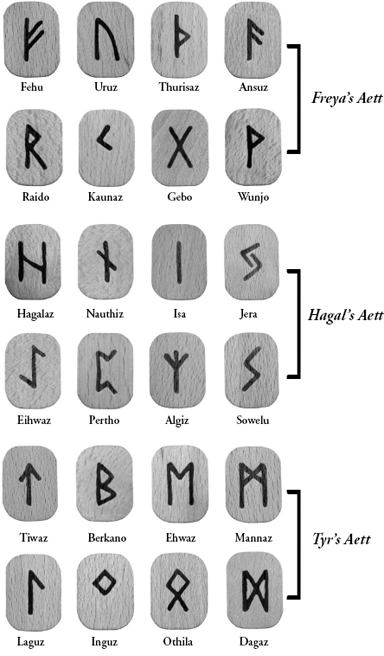
The 24 runes of the Elder Futhark
Fehu, Uruz, Thurisaz, Ansuz, Raido, Kaunauz
Each aet (eight) is named for a Norse god; the three aertir are the aets of Freya, Hagal, and Tyr. The first aet comprise Freya's Eight: Fehu, Uruz, Thurisaz, Ansuz, Raido, Kaunaz, Gebo, and Wunjo. The second is Hagal's Eight: Hagalaz, Nauthiz, Isa, Jera, Eihwaz, Pertho, Algiz, and Sowelo. The third is Tyr's Eight: Tiwaz, Berkano, Ehwaz, Mannaz, Laguz, Inguz, Othila, and Dagaz.
There is a link between the picture, the letter, and the sound that each rune represents. Runes are more properly glyphs rather than simple alphabetic characters. At this distance in time we cannot be completely sure what the individual glyphs are meant to show. As time has passed, the shape of some of the runes has changed. Most sources use the Germanic names for the runes and the Anglo Saxon name is often given in brackets. The difference in meaning under the two systems for the names given can add to our understanding of the runes. The Anglo Saxon names are much closer to modern English and so more accessible to us. Knowing how English developed can help us to understand the runes better. For example, the g in Old English often becomes the letter y in Modern English, a often becomes o and ae becomes a. Using those rules we can look at the names of the Anglo Saxon runes and make more sense of them. For example, Rad becomes roadhighly suitable for a rune connected with travel.
As well as changes in the names and symbols, there has also been a change of attitude toward runes. The Saxons renamed the runes, breaking the links with the pagan gods, but still permitted their use. In later years the Christian Church sought to eradicate the runes, believing (rightly so) that the runes are much more than a mere alphabet and contain magic within the symbols.
The word rune is derived from the Old Norse and Old English run and the Gothic runa, meaning a secret thing, a mystery. Their reputation as a divinatory tool was enhanced when the Christian Church claimed they were used for casting magic spells and communicating with the devil. In recent years the popularity of runes increased when the author J.R.R. Tolkein used a form of runes as dwarfish writing.
Runes, as used today, are a method of divination similar to the Tarot or I Ching. As with the Tarot, different meanings can be given to the runes that fall in the reverse position. Not all runes can be read reversed because of their symmetrical shape, and not all readers differentiate between upright and reversed runes. Runes can be made from any material though most readers choose wood or stone.
Next page
